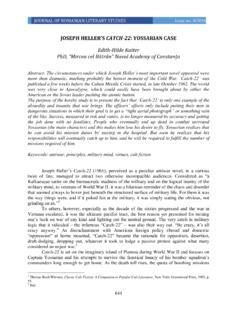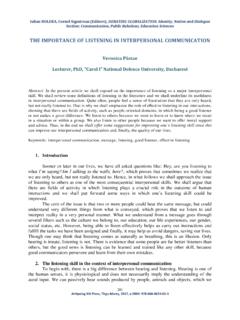Transcription of The competitive advantage of strategic alliances - …
1 The competitive advantage of strategic alliances Natalia Cojohari, doctorand ASE Bucuresti, asistent univ. Universitatea Alecu Russo , B . l i In today's environment, creating sustainable value for customers and shareholders requires creating effective alliances . alliances are essential building blocks for companies to achieve stronger and more effective market presence. alliances are now a fact of life for business, an important piece of current operations as well as future strategy. This article provides an important and useful perspective on strategic alliances . Approaches, examples, models, and other tools are discussed to develop a deeper understanding of how competitive advantage of the alliance can be achieved.
2 The article shows that there are many ways to build a competitive advantage which depend a lot on management of the alliance . Some firms place alliance management under a centralized organization, while others prefer to distribute responsibility for alliances across all business units. Furthermore, the competitive advantage of a strategic alliance also depends on its organizational and strategic circumstances. As the pace of global business accelerates, and customers continually become more demanding and sophisticated, companies are finding the competitive landscape dramatically changing.
3 Markets are moving so quickly that is very difficult for one company to stay current on all technologies, resources, competencies, and information needed to attack, and be successful in those markets. strategic alliances offer a means for companies to access new markets, expand geographic reach, obtain cutting-edge technology, and complement skills and core competencies relatively fast. strategic alliances have become a key source of competitive advantage for firms and have allowed them to cope with increasing organizational and technological complexities that have emerged in the global market.
4 Nowadays, strategic alliances are a business concept that's changing the structure and dynamics of competition throughout the world. Using a broad interpretation, strategic alliance is a relationship between firms to create more value than they can on their own. The firms unite to reach objectives of a common interest, while remaining independent. Companies are forming alliances with their rivals, their suppliers, and even their customers. Increasingly, groups of companies are competing against other groups, changing the distribution of economic power in society and nudging more and more single companies into alliances .
5 In recent years, there has been an explosion of alliances around the world and across industries. For example, in February 2001, The Coca-Cola Company and Procter & Gamble announced a $ dollars joint venture to use Coca- Cola's huge distribution system to increase reach and reduce time to market for the P&G products Pringles and Sunny Delight. Star alliance is the largest partnership in the airline industry; its reach extends to 130 countries and more than 815. destinations, with collective revenue for the partnership at more than $63 billion dollars. Hewlett-Packard and NTT DoCoMo created a partnership to conduct joint research on technology for fourth generation mobile phones, bringing together HP's network infrastructure and computer servers with DoCoMo's wireless broadband technology.
6 alliances take a number of forms and go by various labels. alliances may be contracts, limited partnerships, general partnerships, or corporate joint ventures, or may take less formal forms, such as a referral network. Richard J. Chernesky shows that virtually all strategic alliances fit into three basic classifications of either trading , functional or dynamic operating alliances . A trading alliance is straightforward - nothing more than buyers and sellers forming a largely passive sales and distribution or export/import arrangement based on contractual terms. A functional alliance integrates certain basic functions between the two parties by pooling efforts to attain specific goals and establish ongoing management relationships.
7 These functional alliances are usually used to pursue or improve research and development projects, share costs, provide geographical market access and, generally, enhance distribution or sales activities. A dynamic alliance involves the hidden assets of the two parties in terms of the skills, knowledge and capacity necessary to deliver results. Examples of hidden assets are research and development capabilities, proprietary technology, organizational strength or market-based acceptance. In a dynamic alliance , selected hidden assets are integrated. However, in many instances, the parties do not know exactly what assets are going to be required because the structure of the alliance almost always evolves during negotiations and initial operations.
8 Accordingly, strategic alliances have also been characterized as relational . contracting. Relational contracting is a very flexible arrangement emphasizing mutual collaboration in response to changes in business circumstances. It usually involves a fluid situation that emphasizes receptiveness to modification over time rather than to the detailed and inflexible front-end documentation of expectations. These alliances possess the common feature of ongoing mutual interdependence, a condition in which one party is vulnerable to another whose behavior is not under the control of the first. The overarching theme that seems to unite alliances is that each needs the other's abilities to advance their respective interests.
9 In general, to create successful alliances , a company must understand when alliances make strategic sense and how to manage them for a business results. alliances can be extremely useful in situations of great uncertainty and in markets with growth opportunities that a company either cannot or does not want to pursue on its own. More specifically, the most common reasons for forming strategic alliances and achieve competitive advantages are as follows: Setting new global standards. Entering into an alliance can be the best way to establish standards of technology in the sector. Confronting competition.
10 When a high-volume producer decides to attack a new geographic market, defense is difficult if it does not have comparable size. alliance between companies is a response which has often led to positive results. It is equally valid to attempt an attack on a leader that has consolidated its own positions. Overcoming protectionist barriers. alliances can allow companies to avoid controls on importation and overcome barriers to commercial penetration. alliances can also be a way to respect the bonds posted by the host country regarding value- added local content and participation in the capital of local businesses.










